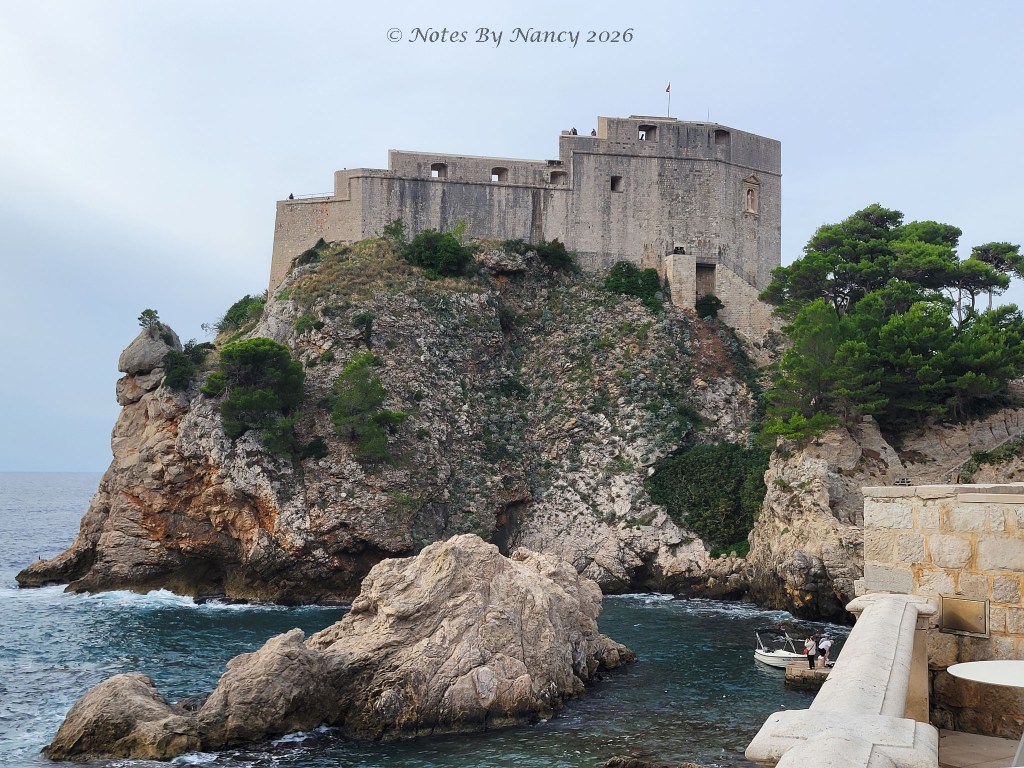For our last full day in Lisbon, we decided to go out of town on a day-trip with our Tours By Locals guide Carla to the mountains and palaces of Sintra, the westernmost point in continental Europe, and the seaside town of Cascais. She picked us up at 8am at our apartment as we had pre-purchased tickets for the 9:30am entry to the colorful National Palace of Pena. It was about a 45-minute drive to Sintra and as we had tickets for the earliest entry time, parking was still readily available nearby. We still had a short wait for the gates to open. Once inside the grounds, it is an uphill climb to the castle. You can walk or take a shuttle. I had a very sore toe in addition to my wrist still hurting, so Dave and I waited for the shuttle, while the others walked. We met them at the shuttle drop-off location to walk the last bit up to the palace.
Just past the palace entry gate, Carla filled us in on the history of the palace which was converted from a former monastery. The monastery was built on the site of a 12th-century chapel by order of King Manuel I (ruled 1495-1521), making it the Royal Monastery. The great earthquake of 1755 left it in ruins; however, it remained active until 1834 when religious orders in Portugal were abolished. In 1836, Queen Maria II married Ferdinand of Saxe-Coburg and Gotha, a relative of the King of Belgium. Ferdinand was recognized as the King-consort and became King Ferdinand II. A patron of the arts and avid collector, he was also known as the Artist King. He fell in love with the mountains of Sintra and began buying land in the area from his personal fortune. His intention was to restore the monastery for use as a summer home. His romantic imagination, however, led him to construct the whimsical palace that exists today. Its architectural influences are primarily medieval with Manueline, Moorish, Egyptian, Gothic, and Renaissance elements. The park grounds surrounding the palace contain tree species from every continent making it the most important arboretum in Portugal. The site remained in the royal family until 1910, when the monarchy was deposed and Portugal became a republic. The palace and grounds were then designated a National Monument. In 1995, UNESCO recognized the Cultural Landscape of Sintra as a World Heritage Site. This area includes many other palaces, castles, and churches. It is indeed a magical, magnificent area with its mountain forests, fantastic views, and elaborate, culturally-significant buildings.
In addition to seeing many interior spaces, we were able to walk around the terraces and a very narrow pathway which encircled the palace for great views of the surrounding area.
After our tour through the Pena Palace, Carla drove us down the mountains towards the coast and the westernmost point of continental Europe, Cabo da Roca. Along the way we drove past several of the other palaces in the area, including the Park and Palace of Monserrate, a 19th-century mansion with Moorish, Gothic, and Indian influences.

Cabo da Roca
We were thankful it was sunny, but even so, the wind made it quite chilly on our walk out to the marker and back. The wildflowers along the path were pretty, but unfortunately, like so many plants in Portugal, many are non-native species which are overtaking native species.
From Cabo da Roca, we headed back towards Lisbon by way of the coastal town of Cascais, known for its beaches, restaurants, and shopping.


Carla had made us a lunch reservation at a restaurant called Furnas do Guincho, overlooking the Atlantic. We ate on the patio, listening to the sound of the waves crashing on the rocks below. Keith got a steak covered in a mushroom sauce, while the other four of us shared the fish of the day. Enjoying the beautiful weather and seaside ambiance, we stretched out lunchtime with desserts, before returning to Lisbon.
Carla dropped us off around the corner from our apartment and we said our farewells.

She was a fantastic, insightful local guide and I highly recommend her. Her information and tours are available on Tours By Locals and can be customized on request like we did. Hiring her greatly amplified our experience in Portugal, not only due to her knowledge but getting to know her and Carlos and about their lives in Portugal gave us additional insight and appreciation for another country’s culture.
We had a relaxing evening back at the apartment, downloading pictures, playing 313, and sadly packing. The next day Dave and I had flights back to Houston, while Keith and Paula were heading to the southern coast of Portugal known as the Algarve. I’ll post a final review of the trip along with a couple of their pictures from the Algarve in a future “note”.






































































Leave a comment